Menus
- Sneackers racer
- Discovery
- In the saddle
- In the city
- Motorway and expressways
- Departmental
- Part-cycle
- Braking
- Comfort / Duo
- Consumption
- Conclusion
- Standard equipment
- Colors
- Option
- The Street Cup in video
Sneackers racer
The rise of motorcycles known as "classics", "neo-retro" or "vintage" could not have escaped your notice. These kinds of machines are all the rage, as they say. Proof of this is with this new Triumph Street Cup which adds to an already rich classic range from the English manufacturer. ! If, for some die-hard bikers, this retro trend can sometimes lack authenticity, we have to admit that these machines, which are generally beautiful and easy to access, attract a clientele who, without these motorcycles, would perhaps not have been. not be interested in our passion. Paradoxically, the classics therefore bring a breath of freshness, even youth, to the motorcycle caste. Triumph understood this well by initiating the advent of this style of machine in the early 2000s by resuscitating the Bonneville myth, with a motorcycle powered by a vertical twin of 795 cm3 (then 865 cm3 from 2006) and resuming literally the aesthetic codes of the mythical motorcycle born in 1959.
The Bonneville of the 2000s will have held up the bar, since it left the Triumph catalog only last year, giving way to the Street Twin, of equivalent displacement, but also to the new Bonneville T120, cubing 1200 cc..
True to its habit of standardization, initiated with the rebirth of the brand in the 1990s, Triumph unveils in 2017 two new versions of the Street Twin, a Street Scrambler version, suitable for soft off-road use and this famous Street Cup, the cafe racer look that we are going to tell you about here.
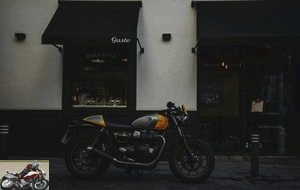
It was in Spain, in the province of Seville, on a varied route, that the little news gave us its handlebars for a ride of 190 km.
Discovery
At first glance at the Street Cup, you can recognize the cafe-racer style, with its backrest saddle and bracelet-style handlebars. The affiliation with the Thruxton models, whether they are in 865 cc as in the past or now in 1200 cc, is evident. Despite this raw style that we owe to the rockers of Ace Cafe London of the 1950s, the spirit has evolved: it has modernized. Indeed, if the Street Cup is the sporting proposition of the Street Twin, Triumph’s desire here is not to offer an aggressive motorcycle but rather "a contemporary urban sports car", as the manufacturer specifies..
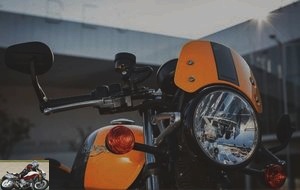
And yes, ends the Triton bitza of the great era, born from the search for absolute performance by speed-hungry bikers who took the powerful Triumph twin to fit it into the more efficient Norton frame. The Street Cup does not display this savagery. What she does offer, on the contrary, is an ounce of sportsmanship in the morning of good manners that will make her a pleasant companion on a daily basis and easygoing on the weekends. A motorcycle without fuss like a good pair of sneakers. You know those urban-oriented sneakers that everyone wears. No way to jog or line up on a basketball court with it. The idea is rather to stroll comfortably in the city while maintaining a small sporty and dynamic look. Surprisingly, despite its delicately vintage silhouette, this is exactly what this new Street Cup offers. A modernized vision of the cafe-racer, favoring fun and accessibility over pure performance.

Placed on its side stand, the Street Cup presents well. The workmanship, like the classic range, is top-notch: nothing is wrong. The English manufacturer has made real progress on this point. Thus, the borders on the fuel tank are applied by hand: an artist’s signature under the tank attests to this according to Triumph. Practical detail, the fuel cap locks. The alloy and 5-Y-spoke wheels also have painted trims. The engine receives a black finish of the most beautiful effect, enhanced by polished cylinder fins and golden covers of the most beautiful effect. Chic, the dark red of the pest control is reminiscent of Bakelite, this material with good electrical insulation qualities used in the past on motorcycles. Very elegant, the butterfly case receives a brushed and perforated aluminum cover with eight holes, a nod to the air filter elements present on the Bonneville models at the end of the 1960s..
The saddle has a black coating reminiscent of the softness of Alcantara down, with silver gray stitching for a neat finish. The mirrors are placed at the end of the handlebars to accentuate the vintage and sporty effect. The taillight is LED but has a classic look, however..
The 2in2 exhaust line ends with satin black conical mufflers and incorporates the catalyst with the utmost discretion. The radiator is nestled between the frame tubes at the front of the engine, thus preserving an "air-cooled" look to this modern twin and now equipped with liquid cooling to meet the requirements of Euro 4 emissions standards..
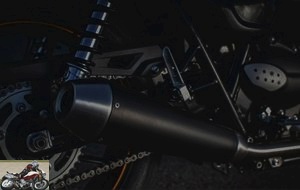
At the helm, the Street Cup, unlike the Street Scrambler and Street Twin, has a dual-dial instrument panel, with the speedometer on the left and the tachometer on the right. The brushed aluminum look of the frame and the chrome bezels contribute to that feeling of refinement and to the pleasures of the eyes that the Street Cup offers. Two small digital screens display all the necessary information, the latter being controlled from the left stalk. On the menu: gear indicator engaged, two trips, a totalizer, a maintenance indicator, range, fuel consumption and gauge, a clock and anti-slip activation. On the right stalk, we have a warning. A little refinement that goes well with our increasingly geeky times: a USB socket is available under the saddle to charge our dear electronic devices.
Note that Triumph offers cruise control and optional heated grips.
In terms of the dress, the Street Cup is adorned with a small headlight cap and a seat cowl to match the tank package. Two colors are available: Racing Yellow / Silver Ice or Jet Black / Silver Ice with gold edging.
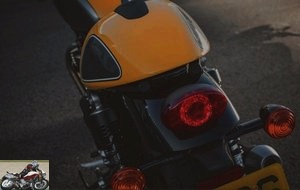
Technique: In-line twin, 900 cm3, 5 hp, 80 Nm, 200 kg
The Street Cup boiler with two parallel bowls is perfectly identical to that of the Street Twin discovered in 2016. To meet Euro 4 emission standards, it is now equipped with liquid cooling which is supposed to reduce fuel consumption by 36% compared to to previous Bonneville vintages. The displayed displacement is therefore 900 cm3 for a maximum power of 55 hp at 5,900 rpm. The maximum torque of 80 Nm is available from 3230 rpm. Previously, Triumph varied the crankshaft timing of its Bonneville twins, to offer a different character between its Scrambler, Bonneville, T 100 and Thruxton. Today, the mechanics of the Street Twin range have been reworked to offer more engine character at mid-speed, with in particular a maximum power revised downwards (less 15 hp) but an increased torque (1.2 Nm) , Triumph maintains throughout its range a 270 ° setting, less linear than a 360 ° setting, where the two pistons go up and down at the same time. Triumph has also refined the character by adapting in particular the electronic management of the injection to the new line of exhaust.

Retro in appearance but decidedly modern in design, the Street Cup, like the Street Twin, offers all the modern technologies that the rider has come to expect on a new motorcycle nowadays. Thus, the 5-speed gearbox receives an assisted clutch which reduces the effort at the lever for increased pleasure, especially during urban developments. The throttle grip operates a single throttle body managed by an electronic ride-by-wire control. ABS braking is of course part, Euro4 obliges. In addition, to support ABS, which is responsible for keeping our wheels on the ground when braking, the Cup receives effective traction control to prevent any evasion of the rear wheel during acceleration, especially on wet and slippery ground. Assistance that you can, however, disconnect if you feel like it.
In the saddle
Once on the handlebars, we discover a driving position that has very little tilting to the front, thanks to the Ace-type handlebars which are less radical than a real pair of bracelets attached to the fork. The Thruxton-like footrests aren’t too far back either. The position is therefore pleasantly sporty, without excess, in order to benefit from a more dynamic behavior without however undergoing it and quickly tiring in town, especially during movements at low speeds, always demanding on the support on the handles. The seat height although slightly greater (780 mm against 750 mm) compared to its roadster sister, is still very reasonable. The general smoothness of the bike makes it easy to feel at ease, with your feet firmly on the ground.
The ergonomics are modern and obvious. The dashboard is controlled from the left stalk. The controls are smooth, both from a brake and clutch standpoint. The speed selection is done effortlessly and with precision. The Street Cup ultimately offering great ease of handling despite its nicely sporty position.
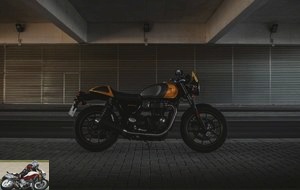
In the city
The first developments instantly confirm the ease of handling this motorcycle. The clutch takes advantage of its assistance to offer a very smooth handling, which is associated with an equally smooth gearbox. Gear changes are relaxed, especially as the clutch and brake levers are adjustable in 4-position spacing. The twin is also very flexible, accepting to drop below 2000 rpm in 5th and final gear (60 km / h). When we flirt with the under revs, we take advantage of the 270 ° setting to feel the twin quivering, without ever subjecting you to unpleasant mechanical vibrations. On the contrary, here everything is soft, round, the Street Cup offering a first-rate urban pleasure. Even its somewhat sporty driving position turns out to be very acceptable in the end, without excessive pressure on the wrists. In 3rd gear, at 2000 rpm, you are going at 60 km / h, but the Cup is of course leaping with more glee. If the mirrors at the end of the handlebars offer excellent visibility, their spacing can nevertheless be a little awkward in the urban gymkhana, between two rows of cars. On the positive side, whatever the speed or engine speed, the mirrors do not vibrate and the reflection is always clear. In short, the results of the urban test are very conclusive, the Street Cup, despite its sporting assets, remaining a motorcycle whose good manners allow you to contemplate the city routes with serenity..
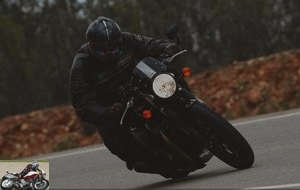
Motorway and expressways
To reach a beautiful and long stretch of road, winding at will, we took a section of motorway and expressways. A journey that gave us the opportunity to appreciate the advantages of the driving position slightly tilted to the front, which compensates for the aerodynamic pressure of the wind. Stalled at 130 km / h, the twin purrs at 4,500 changes per minute on 5th and last gear. At this legal speed, the wind is fine and we like to think that we would be able to cut the road for a longer trip. Even by increasing the pace and positioning the counter needle to 90 miles (ie 145 km / h, 5000 rpm in 5th gear), the driving comfort remains quite acceptable. The headlight cap, although minimalist, also helps deflect the wind. In the end, even if the motorway network is not the best playground for this new Street Cup, we must recognize that it is doing with the honors.
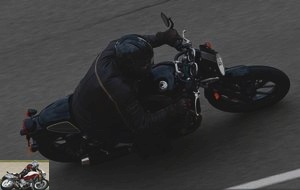
Departmental
To introduce us to its new Street Cup, the Triumph team found a magnificent stretch of road with bends, with a track worthy of a circuit, narrow enough for the 55 thoroughbreds of the twin to feel at their ease; car use of this improbable playground is almost non-existent, what happiness! Obviously, with 55 horsepower, one should not expect the acceleration of a hypersport, but the rigor of the chassis and its excellent handling, allowed us to exploit without restraint the vigor of the twin. If it is expressed ideally between 3000 and 5500 rpm, it accepts without problem to lengthen the stride, up to 7000 rpm of the red zone, or even a little beyond to avoid a change of ratio between two bends, without being stopped in its course by a brutal breaker. The curved handlebars and the footrests borrowed from the Thruxton encourage you to wiggle and quite naturally, as the pace increases, you take pleasure in driving in a more sporty way. Although devoid of hydraulic adjustments, the original suspensions are ultimately up to the task, offering good shock absorption both in compression and in rebound. Only the spring preload of the rear shocks is adjustable, but we didn’t need to adjust it (although set to a bit soft), the trim remaining neutral and the front end easy. Admittedly, with 200 kg dry, the Street Cup does not claim to have the agility of a sporty roadster, but it offers a very easy and reassuring behavior, coupled with good stability in fast curves. Of course, the road being perfectly dry and the Pirelli Phantom SportsComp offering a satisfactory grip, we did not have the opportunity to trigger the anti-skid system, the reasonable power not being in these conditions sufficient to make the rear wheel. On the other hand, in the wet, this assistance can be very useful and above all very reassuring..
Once the session in arsouille mode is over, the Street Cup reveals pleasant behavior on the secondary network, the twin always resuming in a very voluntary way, on the 3rd and 4th gear. And if one might be surprised that Triumph has opted for a gearbox with only 5 speeds and not 6, as is most often the case on a motorcycle, force and recognize that the staging is perfectly suited to this twin of 900 cm3.

Part-cycle
The chassis is very classic and almost identical to that of the Street Twin. The frame is always of the double tubular steel cradle type. The fork is the 41mm Kayaba model with 120mm of travel. 8mm longer, the Kayaba rear shocks are new, but retain the same 120mm of travel. Always adjustable in preload, these new shocks raise the level of the bike at the rear and have a slight influence on the overall geometry of the bike. Thus, the seat height goes from 750 mm on the Street Twin to 780 mm on the Cup; the column angle closes a bit, going from 25.1 ° to 24.3 °, for a reduced trail from 102.4 mm to 98.7 mm. The wheelbase is therefore 4 mm shorter (1411 versus 1415 mm), as Stuart Wood, the engineer responsible for development, told us. With its handlebars placed lower and more forward, thereby implying a greater distribution of masses on the front axle, the Street Cup displays a little more incisive behavior, with a focus on the angle slightly more sporty, without however losing in stability thanks to the longer wheelbase. Compared to the Street Twin, which is very neutral, the Cup therefore offers behavior that correlates with its more dynamic style. Finally, the wheels and tires keep the same dimensions as on the Street Twin, namely, 100/90 x 18 at the front and 150/70 at the rear. Small practical and pleasant detail, the rims are equipped with angled valves, very pleasant to adjust your tire pressure without rotting your hands.
On test, we appreciate the ease of handling the Street Cup, as well as its appreciable handling, preserved thanks to its more closed front end. The stability of the motorcycle is preserved, including in the breaks and other important deformations of the road. In addition, the original damping filters very well the irregularities of the road, thus preserving the overall driving pleasure and comfort..

Braking
Small changes in front braking, with the adoption of a new, more efficient 2-piston Nissin brake caliper. Otherwise no change, still with a single 310mm front disc and a single 255mm rear disc too. Equipment which, supported by ABS, is more than enough to stop the beast’s 200 kg dry. Simple braking but very effective and perfectly in line with the reasonable power of the motorcycle. The feeling is also there, without softness or excessive bite. The rear brake pedal is placed very naturally under the foot, its efficiency allowing perfect control of its trajectory in bends.
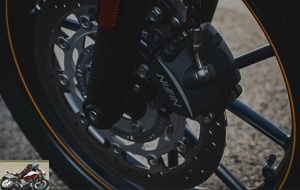
Comfort / Duo
Despite the presence of footrests at the rear, carrying a passenger will be less pleasant than on the Street Twin. The shape of the saddle is indeed narrower and sportier, thus offering a less welcoming seat than the flat saddle of the Street Twin..
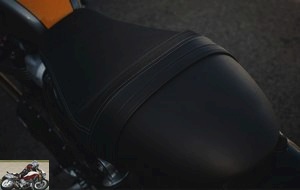
The seat cowl which gives the motorcycle a solo look is supplied as standard. It can be disassembled by removing two BTR screws.
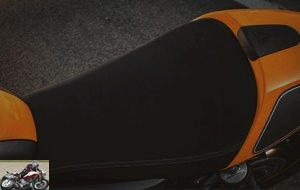
Consumption
Not enough to panic when it comes to fuel consumption. The little sportswoman from Hinckley consumed 5.3 l / 100 km during this test with a nice section that was swallowed hard. Which therefore remains very reasonable. Triumph announces 3.7 l / 100 km in normal driving, or 320 km of theoretical autonomy with the 12 l of the tank, reserve included.
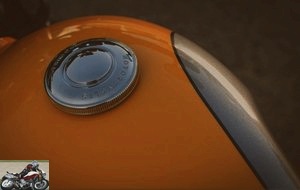
Conclusion
Discovered and acclaimed on the Street Twin, the liquid-cooled parallel twin-cylinder continues to seduce with its qualities of availability and comfort over the usual range of use, that is to say at mid-speed. Euro4 standards oblige, the sound, although attractive by its roundness, remains a tad too hushed to perfectly match the spirit of this contemporary cafe-racer. One could also have imagined that the Triumph staff would give this nice machine a little more gniack, especially as its very healthy-handling chassis could not cope perfectly with it. The choice of Triumph was ultimately one of ease and accessible coziness. So when you put on a good pair of sneakers, you get on the Street Cup for a ride that can turn out to be sportier than you imagine, thus enjoying a successful overall balance bike.
Strong points
- Finishing
- Cafe racer look
- Equipment
- Ease of handling
- Healthy behavior
Weak points
- A little more gniack would have been appreciated on a cafe racer
The Street Cup technical sheet
Test conditions
- Itinerary: small varied roads + interurban highways with a bit of town
- Motorcycle mileage: 190 km
Standard equipment
- Ride-by-wire
- Anti-slip disconnectable
- Assisted clutch
- Coded immobilizer key
- ABS
- LED taillights
- USB plug
Colors
- Racing Yellow / Silver Ice
- Jet Black / Silver Ice
Option
- Heated grips
- Speed regulator
- A2 license kit available
- More than 120 accessories available
The Street Cup in video
Related articles
-
Cool There is freedom in the new Triumph Street Scrambler. A freedom that comes from afar to take you very far. A freedom that has its roots in the…
-
Gentleman Badass Triumph reinvents its flagship model, the Bonneville, in two versions, 900 Street Twin and T120 cubing 1200 cm3, succeeding the T100….
-
Triumph Bonneville Bobber Black test
2 cylinders in line, 1200 cc, 77 hp at 6100 rpm, 106 Nm at 4000 rpm, 237.5 kilos dry, from ¤ 14 350 More muscle, more techno, more dark for the Bobber Is…
-
Triumph Street Triple 675 R motorcycle test
Pocket hooligan… Appeared in 2007, the little Speed quickly gained unanimity around its engine and chassis. With 2,538 units sold in France in 2010…
-
Triumph Street Triple S A2 test
The turbulent English roadster in its version intended for young drivers 3 cylinders in line, 660 cm3, 48 horsepower at 11,000 rpm, 60 Nm at 5,100 rpm,…
-
Triumph Street Triple 765 RS test: the right number
Numerology French bikers are difficult, some would say. False, shall we say. They are experienced amateurs who prioritize quality and performance. This…
-
Harley-Davidson Street Rod Test
Roadstom or Custer: between two saddles A variation of the Street 750 model, the Harley Davidson Street Rod leaves the custom in the locker room and opts…
-
A renewed proposal in a category of “mid-size” trails in full expansion …. 3 cylinders in line, 800 cm3, 95 hp at 9,500 rpm, 79 Nm at 8,050 rpm, 208…
-
Triumph Street Triple 765 RS motorcycle test
The Moto2 roadster 3-cylinder engine, 765 cc, 123 HP, 79 Nm, 166 kg dry, € 11,900 Since its release in 2007, the Street Triple has been a real commercial…
-
Test: Harley-Davidson Street 750
749 cm3, approx. 57 horses at 7,500 rpm, 59 N.m at 4,000 rpm, 206 kilos dry, from € 6,950 The most accessible way to enter the Harley-Davidson universe…
102hp for a 500cc which would take 12000rpm with 38mm carbs…
it’s really little
I am far from adoring Chinese production, and yet this Zontes calls out to me because it dares a certain mix:
"Original" design – even if we find a Ducati inspiration – for a small displacement, with "studied" and not basic parts (see retro, brake fluid reservoir …).
And with a lot of solutions reminiscent of the scooter world, such as numerous plastic covers, integrated passenger footrests, smart key…
What I find unfortunate are the AR suspensions which spoil the visual aspect (a mono shock absorber would have been much more aesthetic) and a price which differs from the productions made in PRC (too greedy importer ???)